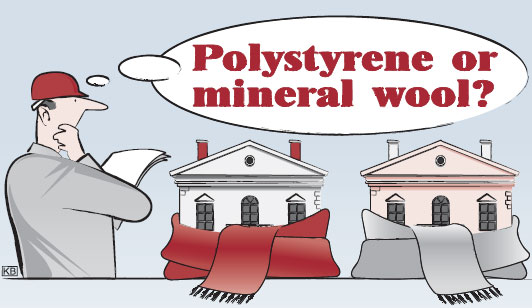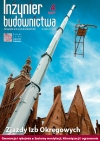The most important reason for insulating buildings is the considerable lowering of heating costs. Also, the walls are protected against dampness, freezing and mould; the insulation layer increases the building’s durability. The question remains – what type of insulation?

Najistotniejszym powodem ocieplania budynków jest znaczne zmniejszenie kosztów ogrzewania budynku. Ponadto, ściany są ochraniane przed zawilgoceniem, przemarzaniem i zagrzybieniem, a warstwa ocieplenia zwiększa trwałość budynku. Pozostaje zatem jedno pytanie – jakie ocieplenie?
I. Wstaw następujące słowa w odpowiednie luki a) – f).
fire code regulations, insulation system, noise transmission, structural weight, thermal conductivity, uniform temperature
Zwróć uwagę, że w zadaniu 3) trzy wyrażenia z ramki mają formę rzeczownik + rzeczownik (noun + noun). W języku angielskim często występują dwa rzeczowniki obok siebie, np. a kitchen table (stół kuchenny), a city street (ulica miasta), a winter break (przerwa zimowa – ferie), car manufacturer (producent samochodów), itp. (patrz też zad. 2). Niekiedy rzeczowniki złożone pisze się razem (housework), oddzielnie (beauty contest) lub z łącznikiem (a house-builder); mogą również składać się one z więcej niż dwóch rzeczowników (fiber glass insulation layer).
1. Exterior thermal insulation is a means of both saving money and making your building more comfortable, as it stays warmer in the winter and cooler in the summer, and a ……………………………………uniform temperature is maintained throughout the house. Insulation can also cut down on noise from outside by reducing ………………………………… noise transmissionthrough the building envelope.
2. There are several ways of insulating the house from the outside, the most popular of which are expanded polystyrene (also called bead board) and mineral wool, both having excellent thermal insulation properties: they have a low ……………………………………,thermal conductivity are breathable, and will aid the release of moisture through the wall.
3. Expanded polystyrene is a relatively low cost material. It is lightweight, so it doesn’t significantly increase the overall
…………………………………… structural weightof the building. Although it is susceptible to mechanical damage, polystyrene foam doesn’t deteriorate, can be used universally even at very low temperatures and, once installed, will require no maintenance.
4. Although expanded polystyrene is an excellent insulator,
…………………………………… fire code regulationsrestrict its use to low-rise buildings due to its high degree of flammability and low resistance to chemical substances. The alternative here is mineral wool, which can be used for buildings of any height because it provides better thermal performance and fire resistance; being non-combustible, it will not aid the spread of fire. On the other hand, in high humidity areas polystyrene may be preferable, as mineral wool can absorb moisture.
5. When choosing an ……………………………………, insulation system there are several factors that need to be taken into consideration, among which are the R–value (insulating power) of the material, weight, density, repair costs, fire resistance, health and environment impact.
W tekście pojawiają się słowa synonimy do słowa wetness – moisture, humidity, dampness. Mają one zbliżone znaczenia – wilgotność – nie są jednak identyczne. Wet oznacza to, co jest pokryte wodą, przemoczone, lub jeszcze nie suche – a wet umbrella, wet paint. Damp i moist znaczą lekko wilgotny, przy czym damp sugeruje nieprzyjemne zawilgocenie – damp, dirty walls; a moist chocolate cake. Humid odnosi się do nieprzyjemnie wysokiej wilgotności powietrza: hot, humid weather.
take into consideration – wziąć pod uwagę
once installed – gdy już zostanie zainstalowany; once oznacza również „jeden raz” – once a day; „kiedyś”, “raz” – I went to France by car once; at once oznacza „natychmiast” – Do it at once!, all at once – wszyscy/ wszystko naraz – It happened all at once
on the other hand – z drugiej strony; on the one hand – z jednej strony
II. W powyższym tekście znajdź angielskie słowa odpowiadające poniższym definicjom. W nawiasie podano numer akapitu, w którym znajduje się dane słowo.
one of several things that influence or cause a situation (5)factor
the repairs that are necessary to keep something in good condition (3)maintenance
the ability of a material to ignite and burn readily (4)flammability
not capable of igniting and burning (4) non-combustible
opposition, lack of response (4), (5)resistance
easily influenced or affected (3)susceptible
the amount of water in the air (4)humidity
become worse (3) deteriorate
{mospagebreak}
III. Uzupełnij zdania odpowiednimi słowami:
factor, maintenance, flammability, non-combustible, resistance, susceptible, humidity, deteriorate
Repair costs result from lack of proper ………………………. maintenance.
Construction materials that are fire–resistant or ……………………….non-combustible. should be used whenever possible.
Heat is a major risk …………………… factor
Temperature and ………………………humidity levels should remain as stable as possible.
The best way to reduce the ………………………. flammability hazard is to eliminate sparks and open flames in the usage area.
III. Przetłumacz poniższe wyrażenia na angielski, tworząc rzeczowniki złożone. Wykorzystaj słowa z zadania I.
przepływ ciepłaheat transfer
zużycie energiienergy consumption
remont powłoki budynkuenvelope repairs
siła wiatruwind force
wyciek wodywater leakage
narzędzia pomiarumeasurement tools
kontrola jakościquality control
wymagania odn. parametrówperformance requirements
zakres temperaturtemperature range
utrata ciepłaheat loss
materiały budowlaneconstruction materials
wykorzystanie materiałówmaterial use
Study Tip!
Jak wiadomo, w nauce języka obcego ważna jest systematyczność. Dobrze jest włączyć naukę języka w codzienny rozkład zajęć, tak aby poświęcić jej czas w określony dzień o określonej godzinie. Nie musi to być tradycyjne „wkuwanie” – w ciągu pół godziny można przeczytać fragment książki, napisać kilka zdań pamiętnika po angielsku, przetłumaczyć ulubioną piosenkę, porozmawiać przez internet z osobą z innego kraju itp. Jeżeli jednak nie jest to możliwe, z braku czasu lub motywacji, warto wtedy zdecydować się na uczestnictwo w kursie językowym lub prywatnych lekcjach.

Aneta Kaproń
Artykuł zamieszczony
w „Inżynierze budownictwa”,
kwiecień 2007.





